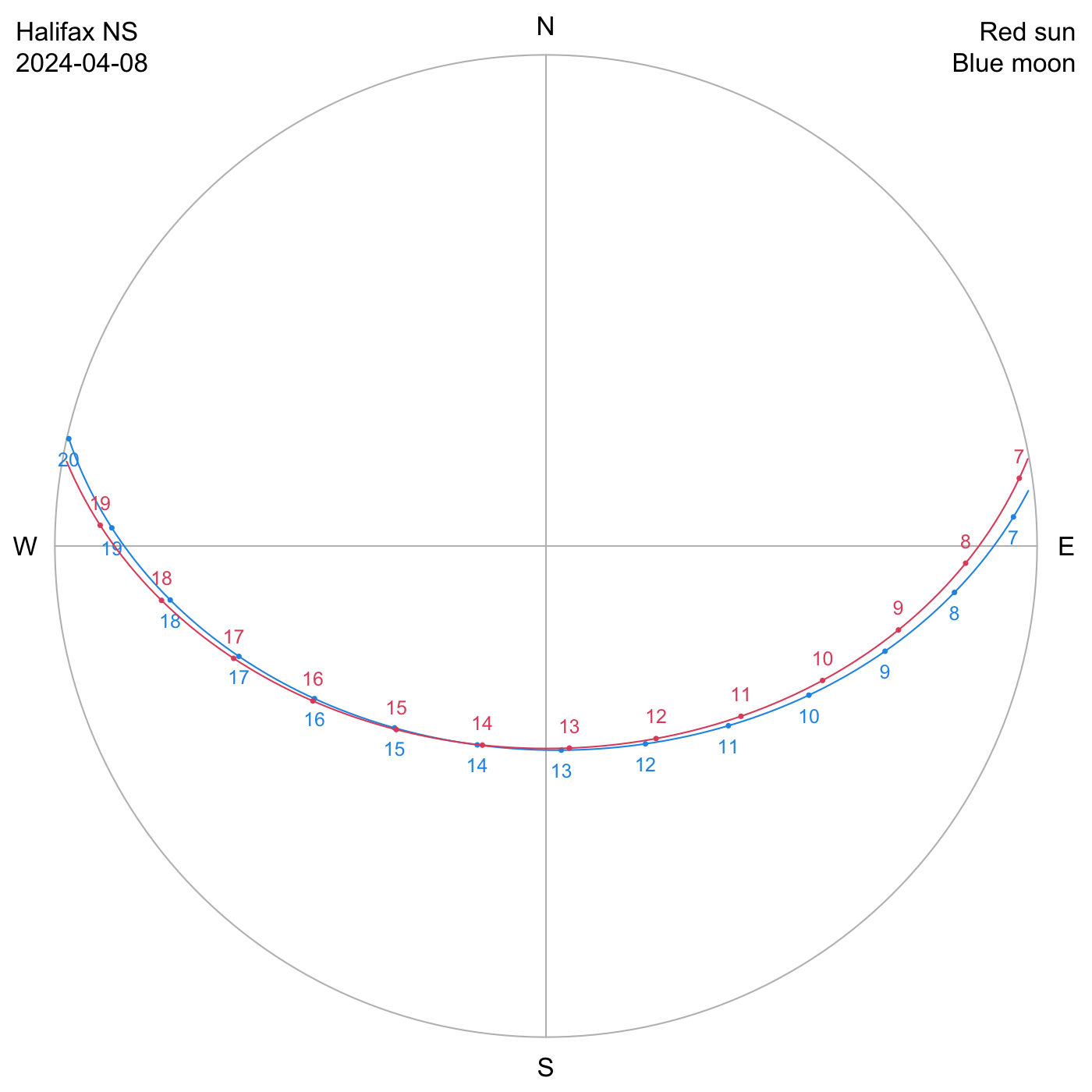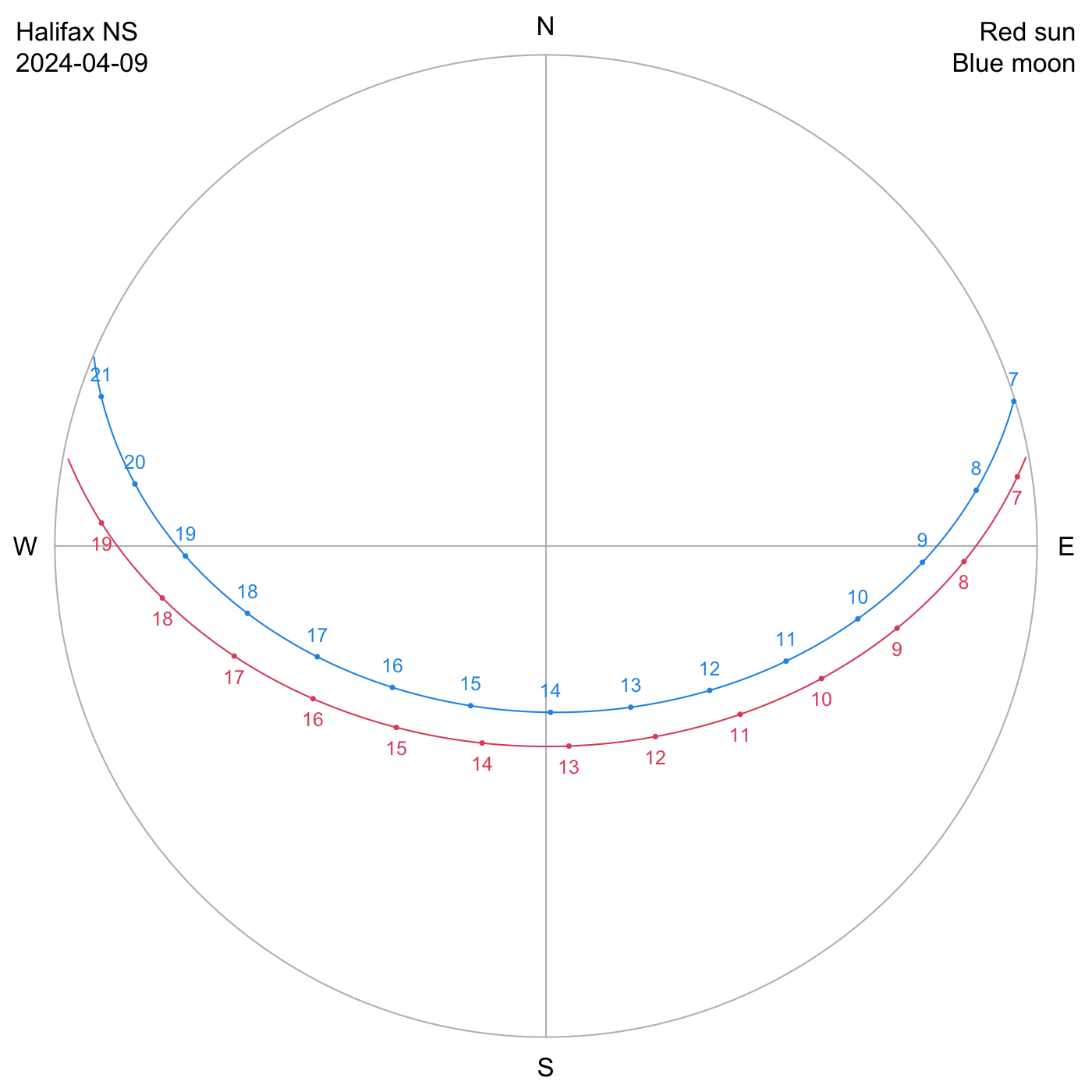Sun and moon paths in daily sky
Introduction
Much of North America will experience a solar eclipse on 2024-04-08 (reference 1). At Halifax, Nova Scotia, the eclipse will be partial, starting at 15:27 local time. A few hour’s drive from Halifax, the eclipse will be total. If the day is not too cloudy, there should be a lot of people experiencing this event. Several websites provide advice for how to experience such events safely, without risking severe permanent eye damage.
The oce functions moonAngle() and sunAngle() can provide a crude
indication of conditions on that day, and the purpose of this posting is to
show how. It must be noted that more detailed calculations are required for
accurate eclipse predictions. Chapter 52 of reference 2 discusses this matter,
suggesting that readers consult the more specialized tables and formulations
presented in reference 3.
The code given at the bottom of this posting creates the diagrams for the day before the eclipse, the day of the eclipse, and the day after. Notice that the sun and moon traces overlap during late afternoon, as predicted. The separation between the two traces is much greater on the days before and after, as would likely be expected by readers who are familiar with tides, etc.



References
- https://eclipse2024.org/eclipse-cities/city/721.html?searchqry=Halifax+Nova+Scotia%2C+Canada#city_table
- Meeus, Jean. Astronomical Algorithms. 2nd ed. Richmond, Virginia, USA: Willmann-Bell, 1991.
- Meeus, Jean. Elements of Solar Eclipses : 1951-2200. Richmond: Willmann-Bell, Inc. Richmond, 1989.
R code
library(oce)
sunMoonPlot <- function(day, lon, lat) {
angles <- function(day, lon, lat,
tz = "America/Halifax", sun = TRUE) {
tUTC <- t <- seq(as.POSIXct(paste(day, "00:00:00"), tz = tz), length.out = 240, by = "6 min")
attributes(tUTC)$tzone <- "UTC"
a <- if (sun) {
sunAngle(tUTC, lon = lon, lat = lat)
} else {
moonAngle(tUTC, lon = lon, lat = lat)
}
invisible <- a$altitude < 0
a$altitude[invisible] <- NA
a$azimuth[invisible] <- NA
list(t = t, altitude = a$altitude, azimuth = a$azimuth)
}
tz <- "America/Halifax"
s <- angles(day, lon, lat, sun = TRUE)
m <- angles(day, lon, lat, sun = FALSE)
max <- 1.04 * max(c(s$altitude, m$altitude), na.rm = TRUE)
par(mar = rep(0.5, 4))
theta <- seq(0, 2 * pi, length.out = 24 * 10)
radiusx <- cos(theta)
radiusy <- sin(theta)
# Horizon and labels+lines for EW and NS
plot(radiusx, radiusy, type = "l", col = "gray", asp = 1, axes = FALSE, xlab = "", ylab = "")
lines(c(-1, 1), c(0, 0), col = "gray")
lines(c(0, 0), c(-1, 1), col = "gray")
D <- 1.06
text(0, -D, "S", xpd = TRUE) # xpd so can go in margin
text(-D, 0, "W", xpd = TRUE)
text(0, D, "N", xpd = TRUE)
text(D, 0, "E", xpd = TRUE)
# Moon calc
mx <- (90 - m$altitude) / 90 * cos(pi / 180 * (90 - m$azimuth))
my <- (90 - m$altitude) / 90 * sin(pi / 180 * (90 - m$azimuth))
t <- s$t
mlt <- as.POSIXct(sprintf("%s %02d:00:00", day, 1:24), tz = tz)
ti <- unlist(lapply(mlt, function(X) which.min(abs(X - t))))
# Sun calc
sx <- (90 - s$altitude) / 90 * cos(pi / 180 * (90 - s$azimuth))
sy <- (90 - s$altitude) / 90 * sin(pi / 180 * (90 - s$azimuth))
slt <- as.POSIXct(sprintf("%s %02d:00:00", day, 1:24), tz = tz)
si <- unlist(lapply(slt, function(X) which.min(abs(X - t))))
# plot, with labels to avoid overplotting
posFlag <- mean(sy, na.rm = TRUE) > mean(my, na.rm = TRUE)
lines(mx, my, col = 4, lwd = 1)
points(mx[ti], my[ti], pch = 20, cex = 0.5, col = 4)
text(mx[ti], my[ti], 1:24,
cex = 3 / 4,
pos = if (posFlag) 1 else 3, col = 4
)
lines(sx, sy, col = 2, lwd = 1)
points(sx[ti], sy[ti], pch = 20, cex = 0.5, col = 2)
text(sx[ti], sy[ti], 1:24,
cex = 3 / 4,
pos = if (posFlag) 3 else 1, col = 2
)
mtext(paste("Halifax NS", day, sep = "\n"), side = 3, adj = 0, line = -2)
mtext("Red sun\nBlue moon", side = 3, adj = 1, line = -2)
}
# Halifax, Nova Scotia: solar eclipse of 2024, with days before and after
png("2024-02-21-sun-moon-%d.png", unit = "in", width = 7, height = 7, res = 200)
sunMoon <- sunMoonPlot("2024-04-07", lon = -63.61, lat = 44.67)
sunMoon <- sunMoonPlot("2024-04-08", lon = -63.61, lat = 44.67)
sunMoon <- sunMoonPlot("2024-04-09", lon = -63.61, lat = 44.67)